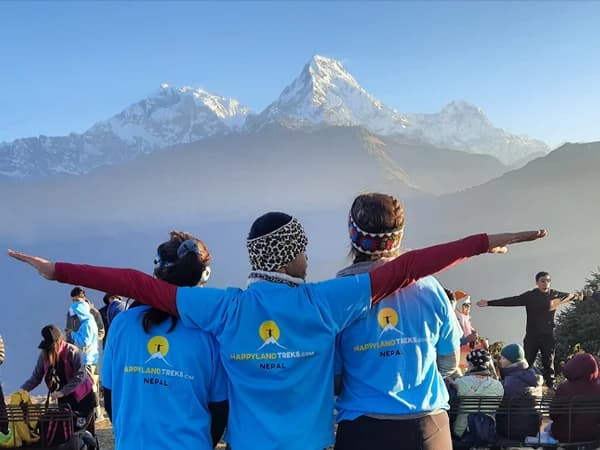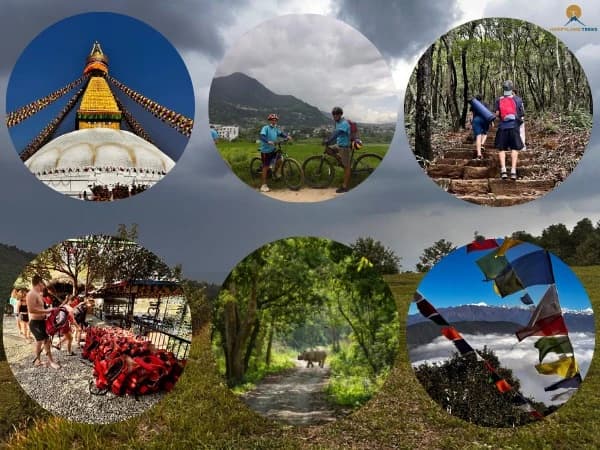The Peak Season for Trekking in Nepal
Autumn
For most trekkers, autumn (September to November) is the best time to visit Nepal. This season offers the ideal trekking conditions that ensure a memorable experience in the Himalayas. The weather during autumn is typically dry, with clear skies and mild temperatures, which creates the perfect conditions for outdoor activities. The daytime temperatures are comfortable, while the nights can be cooler, making it pleasant for trekking at all altitudes. The stunning views of the snow-capped mountains, including iconic peaks like Mount Everest, Annapurna, and Machapuchare, are crisp and clear, offering panoramic vistas that are hard to match anywhere else.
One of the main reasons autumn is considered the best time for trekking in Nepal is that the trails are in excellent condition. Due to the dry weather, the paths remain firm, and there’s little risk of mud or slippery conditions, which are common during the monsoon season. Additionally, the chances of rainfall are minimal, meaning trekkers can enjoy unobstructed views and a more comfortable hiking experience. With stable weather, trekkers can focus on enjoying the natural beauty around them without worrying about sudden changes in conditions.
Autumn is considered the peak season for trekking in Nepal, especially in popular regions like Everest Base Camp, Annapurna Circuit, and Langtang Valley. The trails are busier with trekkers from around the world, as this is the most favorable season for trekking. While the increased number of trekkers means more competition for lodgings and sometimes crowded trails, the stunning scenery and favorable conditions make it worthwhile. The social atmosphere on the trails is also a benefit for those who enjoy meeting other trekkers from different countries and sharing stories.
If you don’t mind sharing the trails with other trekkers, autumn is undoubtedly the best time to enjoy Nepal’s trekking routes at their finest. The weather is stable, and the trekking conditions are comfortable, making it perfect for both beginners and seasoned trekkers alike. Whether you’re setting out for a challenging high-altitude trek like Everest Base Camp or a less demanding route like Ghorepani Poon Hill, autumn ensures that you experience the very best of Nepal’s trekking landscapes and culture.
Winter
While winter (December to February) is the low season for trekking in Nepal, it can still be a rewarding experience for experienced trekkers. Temperatures can drop significantly, especially in the higher altitudes of the Annapurna Region or Everest Base Camp, making trekking more challenging. Snowfall is common, especially in mountain passes and higher regions, which creates snow-covered landscapes and breathtaking views. However, these colder temperatures can also make the trails more treacherous and less accessible.
Trekking in winter offers a solitary experience with fewer trekkers on the trails, allowing you to enjoy the natural landscapes in their purest form. If you're planning a 14-day trek or a trek in the Dolpo Region, you’ll find fewer crowds but should be prepared for harsh weather conditions. It’s important to keep an eye on weather forecasts and carefully plan for colder temperatures.
Monsoon
The monsoon season (June to August) is the least ideal time for trekking in Nepal. The heavy rainfall during the summer months leads to slippery and muddy trails, increasing the risk of landslides and making treks more difficult. However, the rain shadow areas of Nepal, such as parts of the Annapurna Region, can still be trekked during this time due to their lower rainfall levels. For most trekkers, though, the monsoon season is best avoided as it affects visibility and can make trekking uncomfortable.
Best Things to Keep in Mind for a Successful Trek
When planning your trek, it’s essential to consider factors like your fitness level, the type of trek you want to do, and trekking permits. For popular treks like the Annapurna Base Camp Trek or Everest Base Camp, it’s crucial to plan ahead to ensure you secure the necessary permits and a licensed trekking guide. During the peak seasons, it’s advisable to book accommodation in advance as tea houses and guest houses can fill up quickly.
Whether you're planning to explore the Kathmandu Valley Rim Trek, the remote Langtang Region, or Mardi Himal, Nepal offers a variety of trekking options for adventurous travelers. From challenging treks to shorter treks, the ideal time for your trekking adventure depends on your personal preferences and travel plans. Make sure to carefully consider the weather conditions, trek costs, and your fitness level when selecting the best time for your journey.
Conclusion:
The best time for trekking in Nepal is during autumn (September to November) and spring (March to May). Both seasons offer pleasant weather, clear skies, and good trekking conditions, allowing you to enjoy Nepal’s natural beauty at its best. Autumn is the peak trekking season, offering the clearest views and the most popular trekking routes, while spring offers a quieter experience with blooming flowers and a peaceful atmosphere.
If you're new to trekking, autumn is probably your best bet. However, if you prefer fewer crowds, spring might be the perfect time for you. While winter and monsoon can still be viable options for experienced trekkers, they come with challenges like cold temperatures or heavy rainfall, which can make trekking difficult.
No matter when you choose to visit, Nepal offers a trekking experience like no other. Just make sure to plan ahead and choose the right season that fits your preferences and trekking abilities.



